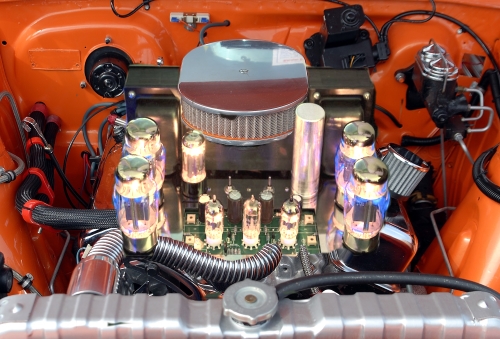Another long lost article from the late, great Recording Engineer/Producer (RE/P) magazine.
“I have a speaker cabinet that says it’s rated at 300 watts. What size power amplifier should I get to hook up to it?”
That simple question, posed recently by a part-time musician who had to deal with his group’s sound system, made me stop and think for a minute about power. About watts, ohms, and all of those other things named after English and German scientists and inventors a century or two ago.
On the surface, it seems simple: you need to raise the level of an audio signal and connect that more powerful output to a loudspeaker, at which point you will convert electrical energy into acoustical, with a bit of waste heat as a by-product. Hopefully, the power amplifier will handle most of this process…if the speaker ends up being responsible for too much of the waste heat, then it’s goodbye sweet sound, hello burned-out voice coil.
How to best choose a power amplifier for use in professional sound systems? What else is there beyond lowest price, highest power rating, and least weight?
In the past, someone once called an audio power amplifier nothing more than a “wire with gain.” Others claim that amps are “all alike,” that they have no “sound,” and that you really can’t detect any audible difference in an A-B comparison. In truth, there are differences between different types and models of power amps.
The musician with the 300 watt speaker cabinet assumed that he should get a 300 watt amplifier. A watt is a watt, right? That might at first seem like a good rule of thumb, but things can be a bit more complicated than that.
What type of program input was the amplifier measured with? How about the loudspeaker? Are these “A.E.S. standard” watts, or “music power watts” or “Peak power” watts, or something in between? Do some loudspeaker manufacturers measure their speaker products’ power handling ability conservatively (so as to not be embarrassed by too many failures) and do some power amplifier manufacturers go the other direction with their wattage rating claims, so as to appear to be the most powerful for the buck? And, if so, how to tell what model to get for a certain application?
Specsmanship aside and marketing claims aside, there are some more basic questions that anyone should ask when power amplifiers are under consideration for sound reinforcement use. I’m not referring here to brand names as much as specific circuit design, available user features and product package configuration (size, weight, cost, power rating, etc.).
Here are a few things that sound reinforcement professionals, system designers, sound rental firms and other professional users consider:
— How much total system electrical headroom is desired for the type of use that the system is most likely to encounter? [Power amplifier headroom will help to prevent audible distortion and will actually place less stress on loudspeaker components than a zero-headroom system. 10-20% is a minimum for everyday ‘normal’ use applications, 25-50% for heavy-duty rock’n’roll usage, and some audio fidelity purists providing sound reinforcement systems for opera and symphonic use like to go with 100% headroom for very accurate amplified transient response.]
— What’s more important: a good pricing deal for mass quantities of amps from a single supplier, or optimized amplifier applications based on exact needs? [Lows, mids and highs in a sound system often work best with different design types or products from different manufacturers, depending on the loudspeaker component characteristics and system use requirements. The right amp for the upper-mid section of a large-venue sound system may not be the best one to use for cue monitoring at the console, or arena subwoofer amplification, or driving the lows in your stage monitor system.]
— Does the power amplifier need to do anything else besides amplify an input signal? [Many amp manufacturers are now offering plugin signal processing options, like electronic crossover modules, high-pass filters, and limiters. Some offer computer-control modules that enable the amplifier unit to be linked into a ‘network’ of similar devices, all monitored and controlled by a personal computer in a remote location.]















